Released in 1940, Pinocchio is a Disney classic still appreciated by children and adults around the world. However, the story of this wooden marionette conceals a great spiritual allegory based on esoteric teachings, which is rarely discussed. We will look at the origins of this animated adventure and its underlying meaning.
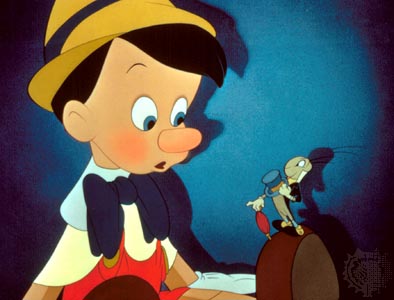
I first watched Pinocchio as a child on a poorly recorded VHS tape with my little brother while eating honey nut loops. I enjoyed the catchy tunes and Jiminy Cricket. I was, however, terrified by the Coachman and I did not quite like the underwater part. That’s pretty much what I remembered of this Disney classic until recently. On a lazy Sunday night, I came across the “digitally remastered” movie on TV and I watched it “for old time’s sake”. What was supposed to be a fun trip down memory lane became a shocking revelation: Pinocchio was one of the deepest movies I’ve ever watched. Could it be a huge allegory about spirituality and modern society? Did I detect hints of initiation into occult Mysteries? I immediately started to research Pinocchio’s origins and all of my theories were abundantly confirmed.
Needless to say, this movie is now a staple in today’s popular culture. How many people have NOT watched this movie? On the other hand, how many people are aware of Pinocchio’s true underlying meaning? Behind the story of the marionette trying to become a good boy is a deep spiritual story that has its roots in Mystery schools of occultism. Through the eyes of an initiate, the children’s story about “being good” filled with lessons about ”not lying” becomes a man’s quest for wisdom and spiritual enlightenment. The brutally honest social commentaries of Pinnochio depicts a grim vision of our modern world and prescribes, perhaps, a way to escape its traps. Through the author’s background and literary references, one can understand the hidden gnostic meaning of Pinocchio.
Pinocchio’s Origins
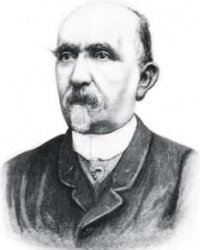
- Carlo Lorenzini aka Carlo Collodi
Pinocchio was originally written by Carlo Lorenzini (known by his pen name, Carlo Collodi) between 1881 and 1883 in Italy. Lorenzini began his writing career in newspapers (Il Lampione and Il Fanfulla ), where he often used satire to express his political views. In 1875, he entered the world of children’s literature and used this outlet to transmit his political convictions. The series Giannettino, for example, often referred to the unification of Italy.
“Lorenzini became fascinated by the idea of using an amiable, rascally character as a means of expressing his own convictions through allegory. In 1880 he began writing Storia di un burattino (“The story of a marionette”), also called Le Avventure di Pinocchio, which was published weekly in Il Giornale dei Bambini (the first Italian newspaper for children).”
-Source
Le Avventure di Pinocchio, a fairy tale describing the adventures of a stubborn marionette in his quest to become a real boy, was published in 1883 (you can read the original book here, if you wish).
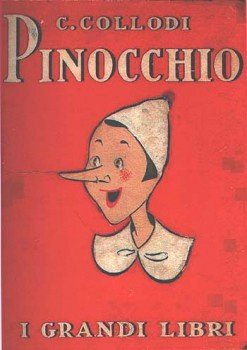
Lorenzini’s work was not solely political. His writings, especially Le Avventure di Pinocchio contained a great deal of metaphysical aspects that are often overlooked by modern readers. One important fact needed to fully understand the depth of Lorenzini’s work is that he was an active Freemason. In an essay called Pinocchio, mio Fratello (Pinocchio, my Brother) Italian Freemason Giovanni Malevolti describes the Masonic background of Lorenzini:
“Carlo Collodi’s initiation into Freemasonry, even if cannot be found in any official records, is universally recognized and often referred to. Aldo Mola, a non-mason who is generally defined as an official historian of Freemasonry, has expressed with great certitude the writer’s initiation into the Masonic family. Events in Collodi’s life seem to further confirm this thesis: the creation in 1848 of a paper called “Il Lampione” (The Beacon), which, as stated by Lorenzini, “illuminated all who were teetering in darkness”; he also considered himself a “passionate disciple of Mazzini” (a prominent Italian Freemason and revolutionary).”
Collodi can also be found in this document published by The Grand Lodge of All England listing famous Freemasons.
Malevolti continues:
“There are two ways to read “The Adventures of Pinocchio”. The first is what I would call “profane” where the reader, most probably a child, learns about the mishaps of the wooden puppet. The second is a reading from a Masonic point of view, where heavy symbolism will complete, without replacing, the simple and lineary narration of events”.
- Giovanni Malevolti, Pinocchio, mio Fratello (free translation)
Lorenzini wrote Pinocchio following the long tradition of mystic texts: a simple narrative story that can be enjoyed by the masses with a hidden meaning reserved to those “in the know.”
Analysis of the Movie
There are many differences between Collodi’s book and the Disney movie. The storyline has been simplified and Pinocchio became an innocent, happy-go-lucky character rather than the stubborn and ungrateful misfit from the original book. All of the fundamental elements are still however present in the movie adaption and the underlying message remains untouched. (I’ve heard you can watch the whole movie here, but I’m not sure).
The Creation
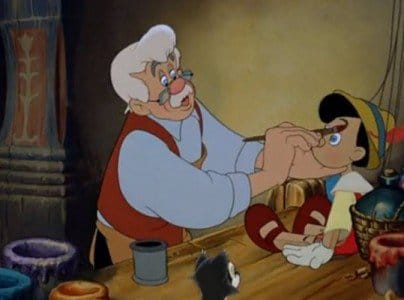
The movie starts off with Geppetto, an Italian woodcarver, turning a piece of wood into a marionette. He gives the puppet human-like features, but it remains a lifeless puppet. Geppetto is, in some ways, the Demiurge of Plato and of the Gnostics. The word “Demiurge” is literally translated from Greek to ”maker, artisan or craftsman.” In philosophical terms, the Demiurge is the “lesser god” of the physical world, the entity which creates imperfect beings who are submitted to the pitfalls of the material life. Geppetto’s house is filled with clocks of his craft, which, as you might know, are used to measure time, one of the great limitations of the physical plane.
“Out of the pleroma was individualized the Demiurgus, the immortal mortal, to whom we are responsible for our physical existence and the suffering we must go through in connection with it”
- Manly P. Hall, Secret Teachings of All Ages
Geppetto has created a great-looking marionette, but he realizes that he needs the help of the “Greater God” to give Pinocchio the divine spark needed in order to become a “real boy” or, in esoteric terms, an illuminated man. So what does he do? He “wishes upon a star”. He asks the Greater God (the Great Architect of the Masons) to infuse Pinocchio with some of its divine essence.
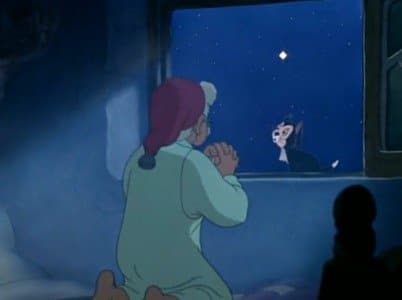
- Could this star be Sirius, the Blazing Star of Freemasonry?
The “Blue Fairy”, the representative of the Great God, then descends to earth to give Pinocchio a spark of the Universal Mind, the “Nous” of the Gnostics.
“It was affirmed by the Gnostic Christians that the redemption of humanity was assured through the descent of Nous (Universal Mind), who was a great spiritual being superior to the Demiurgus and who, entering into the constitution of man, conferred conscious immortality upon the Demiurgic fabrications.”
- Ibid.
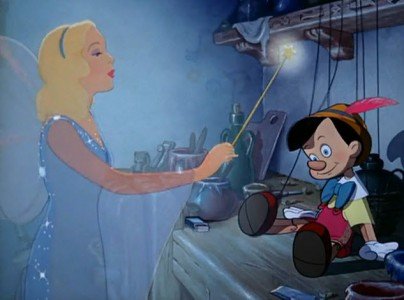
The Fairy confers to Pinocchio the gift of life and free will. Although he is alive, he is not a yet a “real boy”. Mystery schools teach that real life only starts after illumination. Everything prior to this is nothing but slow decay. When Pinocchio asks “Am I a real boy?“, the Fairy replies “No, Pinocchio. To make Geppetto’s wish come true will be entirely up to you. Prove yourself brave, truthful and unselfish and someday you will be a real boy“.
This theme of self-reliance and self-improvement is strongly inspired by Gnostic/Masonic teachings: spiritual salvation is something that has to be deserved through self-discipline, self-knowledge and intense will power. Masons symbolize this process with the allegory of the Rough and Perfect Ashlar.
“‘In speculative Freemasonry, a rough ashlar is an allegory to the uninitiated Freemason prior to his discovering enlightenment. A Perfect Ashlar is an allegory to a Freemason who, through Masonic education, works to achieve an upstanding life and diligently strives to obtain enlightenment. In the Fellowcraft Degree, we see the use of the Rough and Perfect Ashlars. The lesson to be learned is that by means of education and the acquirement of knowledge, a man improves the state of his spiritual and moral being. Like man, each Rough Ashlar begins as an imperfect stone. With education, cultivation and brotherly love, man is shaped into a being which has been tried by the square of virtue and encircled by the compasses of his boundaries, given to us by our Creator.”
- Masonic Lodge of Education, Source
The same way Masons represent the process of illumination by the transformation of a rough stone into a smooth one, Pinocchio starts out his journey as a rough piece of wood and will seek to smooth out his edges to finally become a real boy. Nothing is however handed out to him. An inner-alchemical process needs to take place in order for him to be worthy of illumination. He has to go through life, fight its temptations, and, using his conscience (embodied by Jiminy Cricket), he has to find the right path. The first step is to go to school (symbolizing knowledge). After that, life’s temptations rapidly come across Pinocchio’s path.
The Temptation of Fame and Fortune
On his way to school, Pinocchio is stopped by Foulfellow the Fox (not a very trustworthy name) and Gideon the Cat who lure him to the ”easy road to success”: show business. Despite his conscience’s warnings, the marionette follows the shady characters and is sold to Stromboli, the belligerent puppet show promoter.
During his performance, Pinocchio is acquainted with the up sides of the “easy road”: fame, fortune and even hot women puppets.
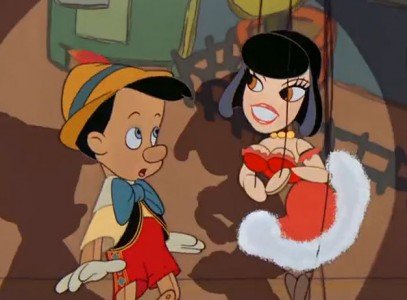
Pinocchio however quickly learns the great costs of this apparent success: he cannot go back to see his father (the Creator), the money he generates is only used to enrich Stromboli, his “handler”, and he sees what fate awaits him when he grows old.
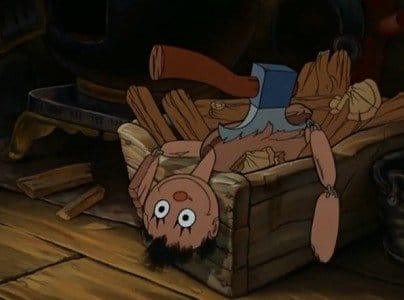
A rather grim depiction of show business, isn’t it? He is basically nothing more than … a puppet. After seeing the true nature of the “easy road”, Pinocchio realizes the sad state he is in. He is caged up like an animal and at the mercy of a cruel puppeteer. He was duped into selling his soul.
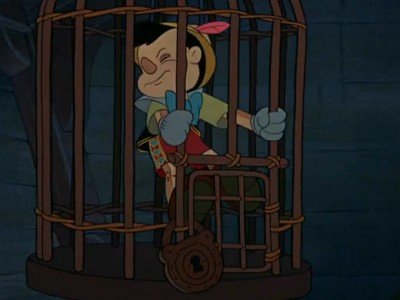
Pinocchio then gains back his conscience (Jiminy Cricket) and tries to escape. All of the good conscientiousness in the world cannot however save him, Cricket cannot open the lock. Nothing less than a divine intervention is needed to save him, but not before he is truthful to the Fairy (the divine messenger) and, most importantly, to himself.
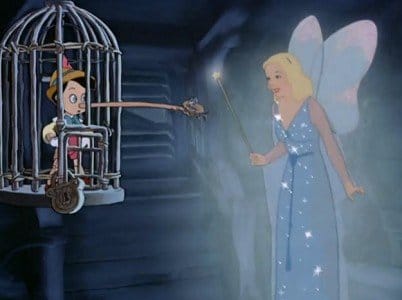
The Temptations of Earthly Pleasures
Back on the right path, Pinocchio is stopped again by Foulfellow the Fox who lures him into going to “Pleasure Island”, a place with no school (knowledge) and laws (morals). Kids can eat, drink, smoke, fight and destroy at will, all under the watchful eye of The Coachman.
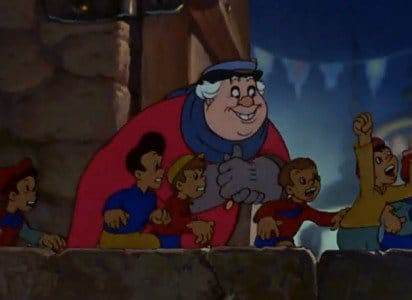
Pleasure Island is a metaphor for the “profane life” characterized by ignorance, the search for instant gratification and the satisfaction of the one’s lowest impulses. The coachman encourages this behavior knowing it is a perfect method to create slaves. The boys who indulge enough into this dumbed-down lifestyle turn into donkeys and are then exploited by The Coachman to work in a mine. Another rather grim depiction, this time of the ignorant masses.
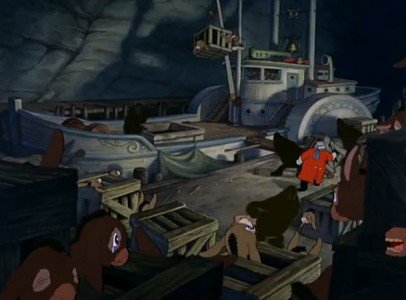
Pinocchio himself starts to turn into a donkey. In esoteric terms he is closer to his material self, personified by this stubborn animal, than his spiritual self. This portion of the story is a literary reference to Apuleius’ The Metamorphoses or Golden Ass, a classic work studied in Mystery schools such as Freemasonry.
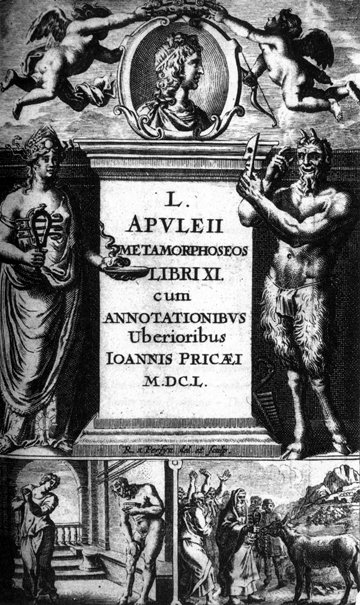
- The Metamorphoses describes the adventures of Lucius who is tempted by the wonders of magic, because of his foolishness, turns himself into an ass. This leads to a long and arduous journey where he is finally saved by Isis and joins her Mystery cult. The story of the Metamorphoses bears many resemblances with Pinocchio by its story line, its spiritual allegory and its theme of occult initiation.
Pinocchio, once he regained his conscience, escaped the prison of profane life and escaped Pleasure Island.
The Initation
Pinocchio returns home to unite with his father but the house is empty. He learns that Geppetto has been swallowed by a giant whale. The puppet then jumps into water himself and gets swallowed by the whale in order to find his Creator. This is his final initiation, where he has to escape the darkness of the ignorant life (symbolized by the womb of the giant whale) and gain spiritual light.
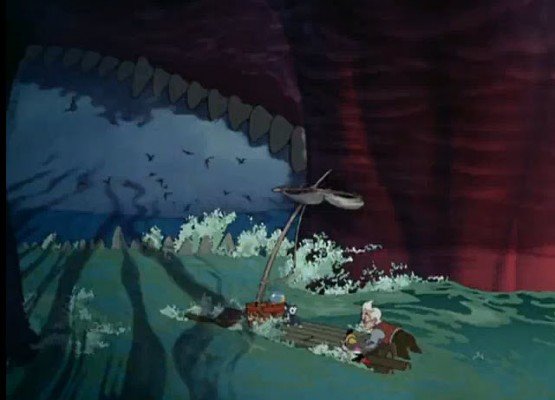
Once again, Carlo Collodi was heavily inspired by a classic story of spiritual Initiation: the Book of Jonah. Found in Christianity, Islam and Judaism, Jonah and the Whale is also read in Mystery schools.
“Jonah is also the central character in the Book of Jonah. Ordered by God to go to the city of Nineveh to prophesy against it “for their great wickedness is come up before me” Jonah seeks instead to flee from “the presence of the Lord” by going to Jaffa and sailing to Tarshish. A huge storm arises and the sailors, realizing this is no ordinary storm, cast lots and learn that Jonah is to blame. Jonah admits this and states that if he is thrown overboard the storm will cease. The sailors try to get the ship to the shore but in failing feel forced to throw him overboard, at which point the sea calms. Jonah is miraculously saved by being swallowed by a large fish specially prepared by God where he spent three days and three nights (Jonah 1:17). In chapter two, while in the great fish, Jonah prays to God in his affliction and commits to thanksgiving and to paying what he has vowed. God commands the fish to vomit Jonah out.”
- Source
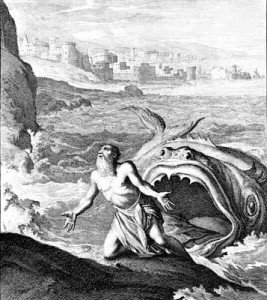
- Jonah after his spiritual initiation
Manly P. Hall explains here the occult meaning of the Jonah and the Whale.
“When used as a symbol of evil, the fish represented the earth (man’s lower nature) and the tomb (the sepulcher of the Mysteries). Thus was Jonah three days in the belly of the “great fish,” as Christ was three days in the tomb. Several early church fathers believed that the “whale” which swallowed Jonah was the symbol of God the Father, who, when the hapless prophet was thrown overboard, accepted Jonah into His own nature until a place of safety was reached. The story of Jonah is really a legend of initiation into the Mysteries, and the “great fish” represents the darkness of ignorance which engulfs man when he is thrown over the side of the ship (is born) into the sea (life).”
- Manly P. Hall, The Secret Teachings of All Ages
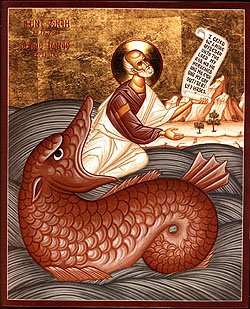
- Jonah emerging from the whale with the word of God
Pinocchio went through the hardships of initiation and came out of the darkness of ignorance. He emerges from tomb resurrected, like Jesus Christ. He is now a “real boy”, an illuminated man who broke the shackles of material life to embrace his higher self. Jiminy Cricket receives a solid gold badge from the Fairy, representing the success of the alchemical process of transforming Pinocchio’s conscience from a crude metal to gold. The “Great Work” has been accomplished. What is there left to do? A crazy accordion party, of course!
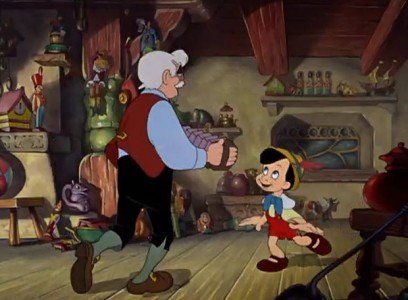
In Conclusion
Seen through the eyes of an initiate, Pinocchio’s story, instead of being a series of random adventures, becomes a deeply symbolic spiritual allegory. Details in the movie that are seemingly meaningless suddenly reveal an esoteric truth or at least a brutally honest social commentary. Inspired by metaphysical classics such as The Metamorphoses and Jonah and the Whale, the story’s author, Carlo Collodi, wrote a modern day tale of initiation, which is the most important aspect of Masonic life. Although Walt Disney’s allegiance to Freemasonry has always been disputed, the choice of this story as the second animated movie ever created by the studio is very telling. Many symbolic details added into the movie manifest a great understanding of the underlying occult meaning of Collodi’s book. Considering the numerous re-releases of Pinocchio and its world-wide success one can say that the entire world has witnessed his path to illumination, but very few fully understood it.
When put in relation with other other articles on this site, which reveal rather sinister meanings, the story of Pinocchio is an example of the nobler side of occult teachings. Striving to achieve a higher level of spirituality through self-improvement is a universal theme found in most religions. Pinocchio still remains typically Masonic and reveals the philosophical background of those in control of the mass media.













































